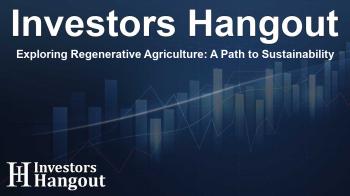Exploring Regenerative Agriculture: A Path to Sustainability

Field to Market Launches New Guidance on Regenerative Agriculture
Today, Field to Market: The Alliance for Sustainable Agriculture introduced the Regenerative Agriculture Guidance Version 1.0, a vital resource designed to assist the agriculture value chain in optimizing their regenerative agriculture practices. This initiative aims to provide effective pathways for achieving sustainability goals and to enhance the overall health of the agricultural ecosystem.
Understanding Regenerative Agriculture
The concept of regenerative agriculture is increasingly gaining traction within the agricultural community. It focuses on practices that restore and enhance the health of soils, ecosystems, and farmers' livelihoods. Field to Market has been at the forefront of this movement, creating a comprehensive definition and a standard framework through collaborative efforts.
Collaboration for Sustainable Practices
Field to Market has established a Regenerative Agriculture Subgroup that comprises experts from various sectors, including agribusiness, brands, retailers, and civil society. This inclusive approach ensures that the guidance developed is comprehensive and actionable. By leveraging combined knowledge and expertise, they aim to equip stakeholders throughout the agricultural landscape with the tools necessary for successful implementation.
Core Pillars of the Guidance
The Regenerative Agriculture Guidance framework is built on three essential pillars: Environmental, Economic, and Social. Each pillar addresses specific aspects that contribute to sustainable agricultural practices.
Environmental Impact
The first pillar addresses the environmental implications of regenerative agriculture approaches. It outlines how practices can be measured and tracked through the Fieldprint Platform, allowing stakeholders to observe their impact on soil health and ecosystem restoration. This data-driven methodology enables farmers and organizations to quantify their efforts towards sustainability.
Economic Opportunities
Economic viability is crucial for the adoption of regenerative practices. The second pillar focuses on providing innovative financing pathways that help support farmers in implementing these practices while ensuring profitability. This financial guidance encourages farmers to transition to sustainable practices without compromising their economic stability.
Social Considerations
Lastly, the social pillar emphasizes the benefits that regenerative agriculture brings to farming communities. It highlights how these practices can lead to improved livelihoods and stronger social ties among farmers, ultimately fostering a sense of community and collaboration.
Impact on the Future of Agriculture
Field to Market's President, Carrie Vollmer-Sanders, expressed pride in launching this guidance, stating that it aligns with their mission to unify the agricultural value chain around sustainability initiatives. The organization's ongoing commitment to updating the guidance with relevant insights ensures it remains a valuable resource for all stakeholders in the agriculture sector.
Continuous Evolution and Updates
The Regenerative Agriculture Guidance will evolve to include further enhancements and insights that reflect the latest developments in the field. This ongoing process underscores Field to Market's dedication to member-driven outcomes and its aim to provide timely resources for regenerative agriculture implementation.
Frequently Asked Questions
What is the purpose of Field to Market's new guidance?
The guidance aims to assist the agriculture value chain in optimizing regenerative agriculture practices and achieving sustainability goals.
What are the three core pillars of the guidance?
The three pillars focus on Environmental, Economic, and Social aspects of regenerative agriculture.
How does the guidance benefit farmers?
It provides actionable strategies to implement regenerative practices while enhancing profitability and community well-being.
Who contributed to the Regenerative Agriculture Guidance?
A subgroup of diverse professionals from agribusinesses, brands, civil society, and more collaborated to develop the guidance.
Will the guidance be updated in the future?
Yes, it will be continuously updated with new insights and enhancements to ensure relevance and effectiveness.
About The Author
Contact Dylan Bailey privately here. Or send an email with ATTN: Dylan Bailey as the subject to contact@investorshangout.com.
About Investors Hangout
Investors Hangout is a leading online stock forum for financial discussion and learning, offering a wide range of free tools and resources. It draws in traders of all levels, who exchange market knowledge, investigate trading tactics, and keep an eye on industry developments in real time. Featuring financial articles, stock message boards, quotes, charts, company profiles, and live news updates. Through cooperative learning and a wealth of informational resources, it helps users from novices creating their first portfolios to experts honing their techniques. Join Investors Hangout today: https://investorshangout.com/
The content of this article is based on factual, publicly available information and does not represent legal, financial, or investment advice. Investors Hangout does not offer financial advice, and the author is not a licensed financial advisor. Consult a qualified advisor before making any financial or investment decisions based on this article. This article should not be considered advice to purchase, sell, or hold any securities or other investments. If any of the material provided here is inaccurate, please contact us for corrections.

